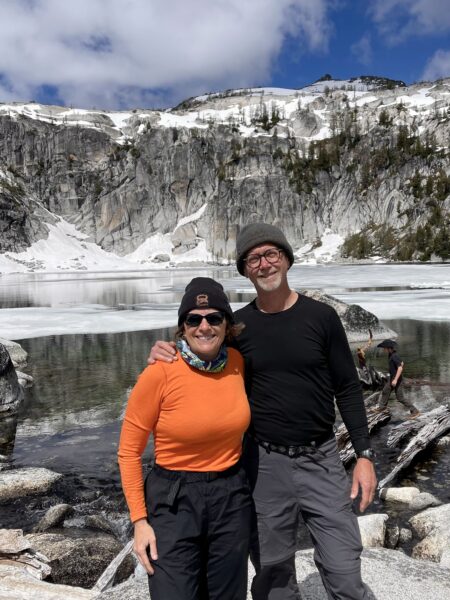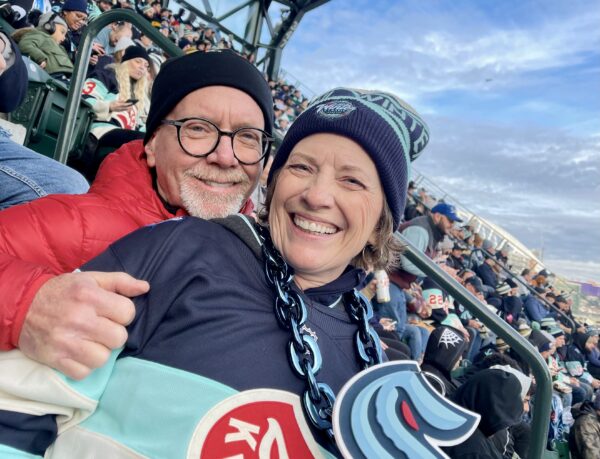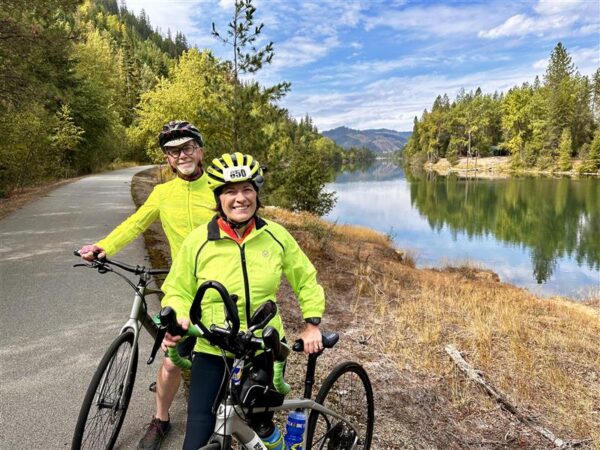Support people play an important role in helping loved ones navigate their hearing journeys. Hank shares how he helps his wife of 45 years with her hearing loss and how a cochlear implant has enhanced their lives.
“Kathy and I met in August of 1979 and were married a year later. Over the next decade, we welcomed three children—two sons and a daughter. We both valued and pursued education. Kathy became a nurse and worked part-time when the kids were in school. As they grew older, she gained more experience and put in more hours. I was in the Air Force and worked in information technology before retiring a few years ago.
We share a love of travel, experiencing new cultures, visiting historical sites, backpacking, hiking, biking, running and maintaining an active lifestyle. In 2018, we embarked on a 14-month bike adventure, riding to all 48 contiguous states. We camped, stayed in houses of friends and with strangers who became friends. Kathy booked a hotel room at least twice a week, per the condition she set when I came up with the idea. It was a great adventure full of surprises, wonderful and sketchy places, trials and tribulations, and beautifully strange people. It was an adventure we’ll never forget, full of memories and stories.
Making the most out of each day wasn’t always easy when Kathy’s hearing loss made her feel like she was missing out.
 Living with hearing loss
Living with hearing loss
Kathy began experiencing hearing loss at 9 years old and received her first hearing aid at 17 years old. A few years later, she added a second hearing aid. During our early years together, her hearing loss wasn’t much of a bother. We’d go to plays, and her hearing aids would do fine the majority of the time.
At some point, she began missing out on a lot of the dialogue, and she didn’t find going to the theater to be as enjoyable. Hearing assist headphones weren’t that helpful, but she would still want to go to shows, I think, for my benefit. She didn’t want her hearing loss to interfere with me. As time went on, we attended fewer stage productions. I stopped bringing up the topic because I didn’t want her to sit through something she couldn’t truly enjoy.
As her hearing loss progressed, I provided daily support to help her and never wanted her to feel embarrassed when she couldn’t hear. I often repeated things for her to make sure she got it. Sometimes I’d have to listen in on phone calls, ‘to hear for her,’ and our TV was always turned up loud so Kathy could hear it.
 When hearing aids aren’t enough
When hearing aids aren’t enough
Kathy had to increase the strength of her hearing aids every few years to keep up with her hearing loss. When the most powerful hearing aids still weren’t enough, she learned more about cochlear implants and decided to go for it. For the past three years, she’s thrived with a bimodal hearing solution— a cochlear implant and a hearing aid. The devices stream together to deliver her best possible hearing.
Practicing patience and providing support
After her cochlear implant was activated, I did everything I could to ease her discomfort, just as I do with any of her medical procedures. I kept the house as quiet and still as possible during her recovery and checked in often to understand what she needed. Fortunately, the pain from surgery was minimal after the first few days.
It took more time for her brain to adjust and make sense of digital signals than I thought it would. The crinkle of a newspaper page or the cracking of an egg would sound like screeching noises to her. Background sounds that I was used to ignoring overwhelmed her. She was hearing everything, but not the way that I did. It was all new sounds that made no sense to her, and her brain wasn’t tuning them out. It took time for that to ease up. That’s my biggest piece of advice for those looking to best support their loved ones who just received a cochlear implant—be patient and manage expectations. Know that your loved one is not hearing sounds the same way you are, and it’s going to take time for them to adjust.
 Winning back shared adventures
Winning back shared adventures
With her cochlear implant, Kathy gets more out of social events. She doesn’t need to pretend to hear conversations anymore. When it’s just the two of us at home, she can remove her device or stream sound directly from a TV or phone, while I practice playing the guitar and/or harmonica. It’s a win-win as she can’t stand the sound of a harmonica! She has more freedom now, and when we’re out biking, traveling, exploring and adventuring together, Kathy can be fully immersed, hearing every sound.”